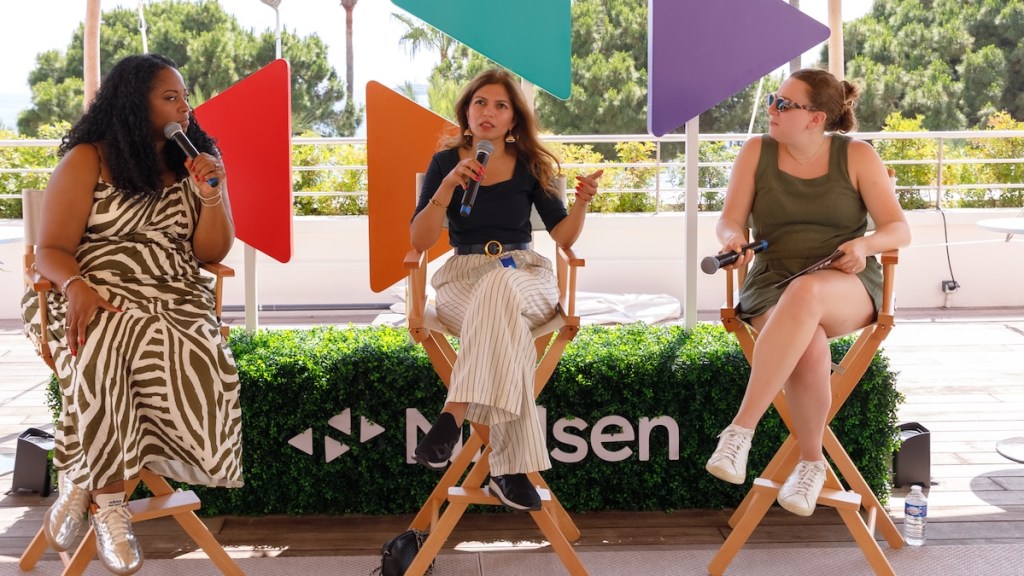This post was created in partnership with Nielsen
For today’s most innovative companies, creators have become essential partners in both marketing strategy and brand storytelling.
During the Cannes Lions International Festival of Creativity, ADWEEK and Nielsen co-hosted “Decoding the Creator Economy,” an invite-only event featuring two panels. One explored how brands and creators can use data to drive greater impact, while the other focused on building authentic partnerships that grow new audiences.
 (L-R) Nielsen’s Amilcar Perez, Unilever’s Mario Dughi, TikTok’s Kim Farrell, Bru on the Radio’s Josh “Bru” BrubakerCreation at the intersection of analytics and authenticity
(L-R) Nielsen’s Amilcar Perez, Unilever’s Mario Dughi, TikTok’s Kim Farrell, Bru on the Radio’s Josh “Bru” BrubakerCreation at the intersection of analytics and authenticity
In the first panel discussion, “Unlocking Creator Impact: Data-Driven Strategies for Brands,” speakers focused on the evolution of the creator economy and the impact of insights-driven strategies within content collaborations.
Mario Dughi, global marketing director at Unilever, highlighted the shift as one from influence to co-creation. “It’s not leveraging people for their audiences but tapping into their creativity in a way that makes sense for our brands,” he said.
Content creator Josh “Bru” Brubaker of Bru on the Radio agreed, and shared that from the creator’s perspective, it’s more about the quality of partnerships than the quantity—collaborating with brands that you truly believe in and match the interests of your audience. The question always on his mind when signing deals, he said, is “how do I stay true to myself and what my audience has come to love about me?”
The talk then moved to the attributes that define a high-performing creator. Kim Farrell, global head of creators at TikTok, shared that, in her view, the three key traits of standout creators are authenticity, deep community understanding, and data-savviness.
“The creators we see really using TikTok Studio and going deep into their analytics are looking at the viewership second by second and the engagement rate,” Farrell explained. “They’re living and breathing the data.” This information is used to both grow their own profile and speak to brands effectively about what they bring to the table for potential collaborations.”
Panel moderator and chief revenue officer of Nielsen, Amilcar Perez, emphasized the growing role of data for creators. He shared that Nielsen is working with creators like MrBeast to provide analytics that quantify the value of their viewership. “Nielsen helped the whole industry for many years with TV currency,” he said. “So, now it’s time to help the content creator currency as well.”
What specific data points and content attributes are most attractive on the brand side when exploring potential collaborations? Dughi said that his team is looking at creative chemistry with the brand, engagement, and sentiment. For each aspect, both quantity and quality matter.
At Unilever, he’s also focused on the number of times content is saved as an incremental additional metric. “Most of our videos are cleaning hacks and tips, so they need to be useful—and a save is a good indication of whether people find the content to be really useful.”
Farrell added that looking at shares is really powerful: “Is this a creator who generates conversation people want to share that content elsewhere or co-create with it?” She also highlighted the power of community in the comments. “When you’ve started to narrow down creators you’re thinking of working with, look at how they engage with the comments and look at the comments they’re getting from that audience.”
 (L-R) Savage X Fenty’s Vanessa Wallace, iHeart Media’s Hetal Patel, ADWEEK’s Alison WeissbrotUsing trusted voices to create partnership content that performs
(L-R) Savage X Fenty’s Vanessa Wallace, iHeart Media’s Hetal Patel, ADWEEK’s Alison WeissbrotUsing trusted voices to create partnership content that performs
Following the first panel, a second panel discussion, “Tuning In New Audiences: The Creator-Platform Revolution,” explored how creator-brand alliances can drive innovative content and mutual audience growth.
Vanessa Wallace, CMO of Savage X Fenty, kicked off the conversation, talking about how creators—especially micro-influencers—help brands reach new audiences with authenticity and personal connection.
Building on that idea, Hetal Patel, president of advertising intelligence at iHeartMedia, noted that creator content taps into a time-tested marketing tool that dates back to the early days of radio: the human voice. “Audio is a very intimate medium,” she continued. “But at the same time, it brings creative freedom that’s unmatched by any other medium—storytelling at its finest.”
Creators, the panel agreed, are skilled storytellers, especially when given the freedom to tailor content and brand messaging to their voice. But getting brands comfortable enough to offer that freedom requires mutual trust.
Wallace shared that Savage X Fenty’s content collaborators are provided with a brief, mood boards, and talking points, but ultimately, “in order for it to resonate on that content creator’s platform, it has to be in their voice.”
“From a measurement standpoint, too,” added Patel, “when brands give talking points instead of actual scripts and let the influencer bring their own realness to it, you see better performance. So, it’s a win-win.”
Tying the conversation to the previous session, the panelists discussed how audience insights and a strategic media mix can enhance collaborative content. Creators are increasingly flexible across mediums, allowing their content to meet their audience at multiple entry points for a wider reach.
“It starts with the consumer, where they digest and consume that content. And I think the goal for a brand is to be authentic wherever they show up,” said Wallace. A key signal Wallace said Savage x Fenty relies on is product feedback. “We get feedback every month on what products are working, what they love, the fabrications, the fit.” Quickly responding to direct consumer insights, she shared, makes brands better.
Building on that point, Patel explained that data-driven audience understanding is key. Analytics are a currency to support marketing hypotheses and make the right strategic decisions to understand “what is the actual reality on the ground,” she concluded.
